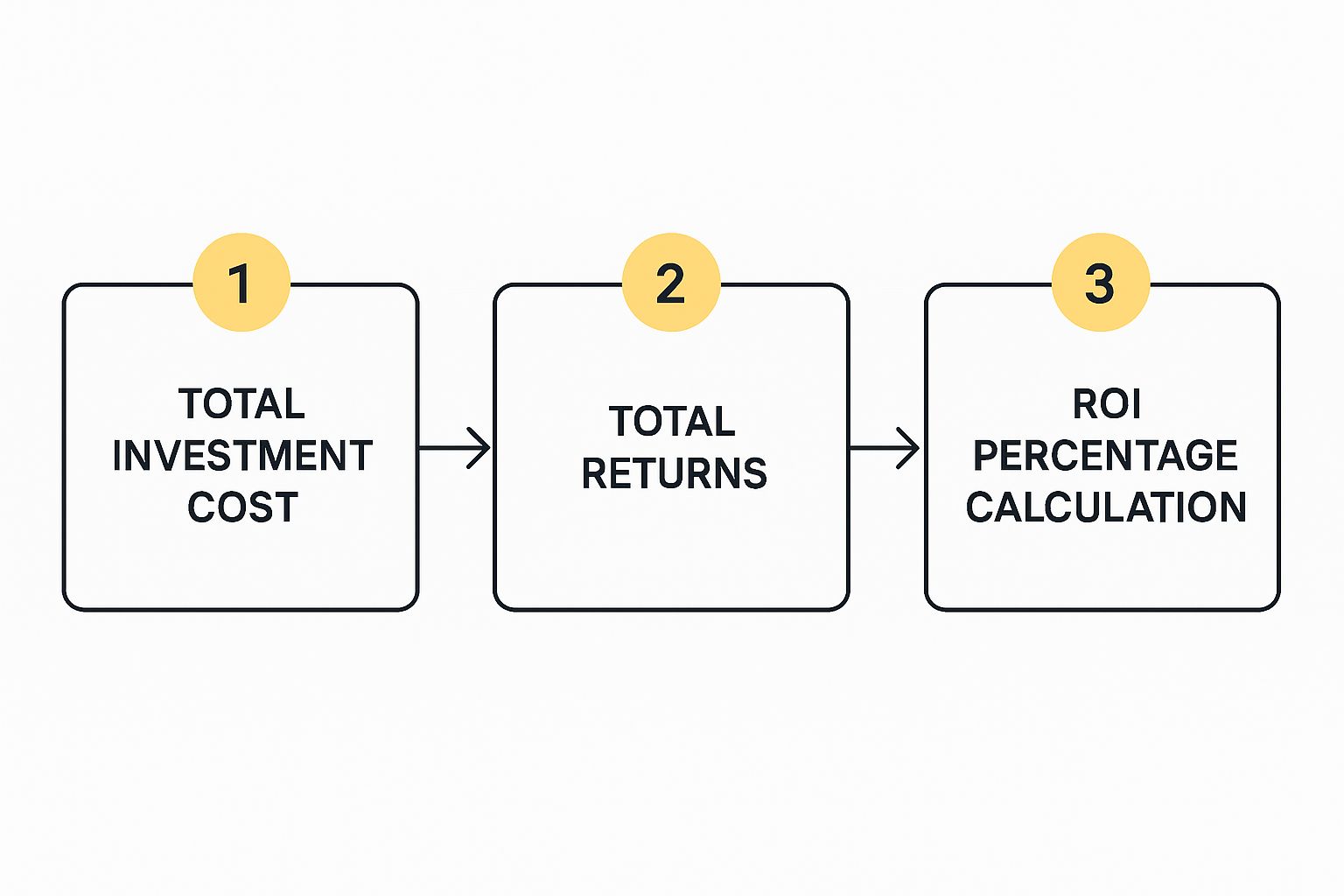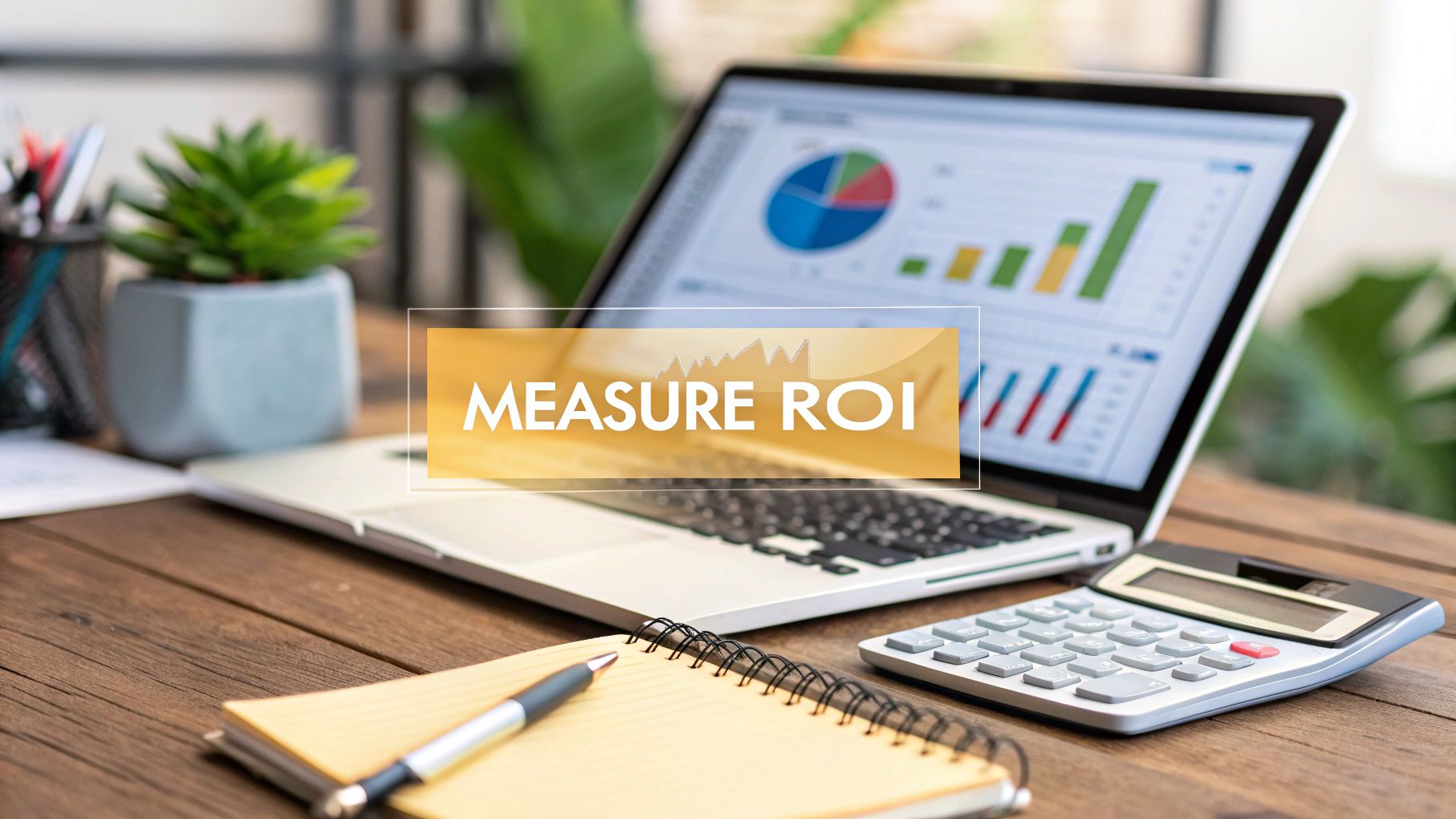Calculating your return on investment (ROI) isn't just about plugging numbers into a formula. It all starts with defining what you're actually trying to achieve in a way that can be measured. You have to draw a straight line from your investment costs to actual revenue, making sure every dollar spent has a purpose.
Setting the Stage for an Accurate ROI Calculation

It’s tempting to jump straight into the math, but that's a classic mistake that leads to numbers without meaning. Before you can get a real sense of your ROI, you need to build a solid foundation of clear, specific objectives.
Without this crucial first step, your final percentage is just a number floating in a vacuum, completely disconnected from any real business impact.
The goal is to move past vague targets. An objective like "boost brand presence" is financially impossible to measure. You have to translate that into something tangible. A big part of this is quantifying the value of user research and other activities to understand what 'value' truly means in different contexts.
From Vague Goals to Measurable Objectives
Let's make this real. Imagine a B2B software company is launching a new product. Instead of saying they want to "increase awareness," they should set a goal like, "generate 200 marketing qualified leads (MQLs) from our SEO efforts this quarter." Now that is a specific target you can track directly against your investment.
Here's another one. An e-commerce store gearing up for the holidays shouldn't just aim to "get more sales." A much stronger, more accountable objective would be: "Achieve a 5:1 return on ad spend (ROAS) for our holiday PPC campaign, resulting in $50,000 in direct revenue."
The key is to connect every marketing activity to a specific, revenue-oriented outcome. This alignment ensures that when you calculate ROI, you're telling a compelling story about how marketing drives business growth.
When you establish these concrete targets upfront, you create a framework for success. Every other step—from gathering data to the final calculation—becomes more focused and credible. You’ll know exactly which KPIs matter, which makes your entire analysis sharper and more actionable. This preparation transforms your ROI from a simple metric into a powerful strategic tool.
The ROI Formula and How to Actually Use It

At its core, the classic formula for return on investment is beautifully simple: (Net Profit / Total Investment) x 100. It’s a clean equation that spits out a percentage, telling you how much you got back for every dollar you put in.
But here's the catch every agency pro knows: the math is the easy part. The real work—and where most people go wrong—is figuring out what numbers to actually plug into that formula.
The marketing world is messy. A short-term Google Ads campaign has totally different costs and returns than a six-month SEO and content strategy. If you try to apply a one-size-fits-all formula, you're going to get a skewed picture of what’s actually working. You have to adapt.
For instance, some investments grow in value over time while also kicking off income, which requires a slightly more nuanced calculation than a simple one-off spend. You can see how this calculation method works across different financial contexts, but for our purposes, let's focus on defining the agency-specific costs.
Nailing Down Your "Total Investment"
This is where ROI calculations often fall apart. The "Total Investment" is so much more than just your ad spend or the cost of a new software subscription. If you want a credible, defensible number, you have to account for everything.
That means digging into costs like:
- Direct Costs: The obvious stuff. This includes ad spend, agency fees, and subscriptions for tools like your email marketing platform or analytics software.
- Indirect Costs: This is the big one people miss. You need to calculate the hourly cost of every internal team member who touched the project and multiply it by the hours they spent.
- Content & Creative: Don't forget the budget for design work, copywriting, video production, or any other creative assets you had to produce.
Forgetting to factor in your team’s time is probably the most common mistake I see. It dramatically—and artificially—inflates your final ROI. If your strategist and designer spent a combined 40 hours on a campaign, that labor cost is a very real part of your investment.
A truly accurate ROI isn't just a vanity metric—it's a business health indicator. Including all direct and indirect costs ensures your final number is defensible and provides a realistic view of profitability.
When you take this comprehensive approach, the ROI figure you present to clients or your leadership team isn't just impressive. It's grounded in reality.
Tracking the Right Data for a Credible Analysis
Your final ROI number is only as good as the data you feed it. Seriously. If your tracking is a mess, your ROI calculation will be, too. To measure this stuff with any real credibility, you need a system that captures every critical touchpoint, from the first ad click all the way to the final sale.
This all starts with getting your conversion tracking set up properly. And no, I don't just mean looking at page views. You need to get into tools like Google Analytics and configure goals that monitor the actions that actually matter to your business—form submissions, demo requests, phone calls, you name it.
This is the foundation. Without it, you're just guessing.

Each stage in that flow needs clean data. Get one part wrong, and the whole calculation falls apart.
Connecting Actions to Revenue
Once you're tracking conversions, the next challenge—and where a lot of agencies stumble—is tying those actions to actual revenue. This is especially tricky for businesses with longer sales cycles where a lead might not become a customer for weeks or even months.
The solution? Integrate your marketing platforms with your Customer Relationship Management (CRM) system. This is non-negotiable.
This integration gives you a single source of truth. It lets you see which marketing channels are generating not just leads, but high-value customers that actually close. For instance, you might discover that a lead from a targeted LinkedIn campaign has a 30% higher close rate than one from a generic display ad. Without that connection, you're just flying blind, celebrating vanity metrics that don't impact the bottom line.
Attribution isn’t about giving one channel all the credit. It’s about understanding the entire customer journey. A solid multi-touch model recognizes that a blog post, a webinar, and a sales call all play a part in closing a deal.
And please, do yourself a favor: get disciplined with your UTM parameters. Consistently using them for all your campaigns is what allows you to precisely track the source, medium, and campaign for every single click. It’s a simple practice that prevents your analytics from becoming a tangled, useless mess. This little bit of discipline is what separates the pros from the amateurs when it comes to measuring ROI.
Putting Your ROI into Context with Benchmarks

So, you’ve done the hard work and calculated your return on investment. The very next question you’ll hear from a client or your boss is always the same: "Is that number any good?"
Honestly, an ROI figure floating in a vacuum is just a number. It's the benchmarks that give it meaning and tell you whether you should be celebrating or heading back to the drawing board.
This context is everything because a "good" ROI isn't some universal constant. It swings wildly between different marketing channels, not to mention industries. For instance, a 5:1 ratio (meaning you make $5 for every $1 spent) might be a massive win for a competitive Google Ads campaign. But that same 5:1 return could be considered just okay for a mature email marketing or SEO strategy, where the returns can often climb much higher over time.
If you're looking to bump those numbers up, our guide on conversion rate optimization strategies is packed with tactics that can help.
Finding the Right Comparison Points
The absolute best place to start is with your own historical data. Digging into your past performance creates internal benchmarks that are perfectly tailored to your business. This helps you track real progress year over year and set goals that are ambitious but still grounded in reality.
Once you have your internal baseline, it's time to look outward:
- Industry Reports: Plenty of marketing analytics firms publish annual reports that break down ROI benchmarks by channel and sector. These are goldmines for understanding the broader landscape.
- Competitor Analysis: You won't get their exact P&L, but you can get a feel for their performance by analyzing the intensity and focus of their marketing efforts. Are they pouring money into video ads? Dominating organic search? That tells you where they're likely seeing a return.
Think of it like investing. A single year's stock market return doesn't tell the whole story. You need long-term context and historical averages to truly understand performance.
Adopting this same mindset for your marketing ROI will help you make smarter, more informed decisions about where your budget is best spent. It allows you to build a more nuanced picture that manages expectations and tells a story of steady, strategic growth.
To give you a clearer picture, here's a look at what you can generally expect from different channels.
Typical Marketing ROI Benchmarks by Channel
This table provides a general overview of expected ROI for various digital marketing channels to help agencies set realistic performance targets.
| Marketing Channel | Average ROI Ratio (Return:Investment) | Considerations |
|---|---|---|
| Email Marketing | 36:1 to 42:1 | Consistently the highest ROI channel. Relies on a quality, engaged list. |
| SEO | 22:1 | A long-term investment. ROI compounds over time but takes months to show results. |
| Content Marketing | Varies (often tracked via SEO) | Harder to measure directly, but fuels SEO and lead generation. High long-term value. |
| PPC Advertising | 2:1 to 8:1 | Highly dependent on industry competition, ad platform (Google vs. Social), and campaign optimization. |
| Social Media Marketing | 2:1 to 5:1 (Paid) | Varies greatly by platform. Organic ROI is more about brand building and is harder to quantify. |
| Affiliate Marketing | 15:1 | Performance-based model means lower risk, but requires strong partner relationships. |
Keep in mind, these are just averages. Your actual results will depend on your industry, strategy, and execution. The key is to use these numbers as a starting point to frame your own performance and identify areas with the most potential for growth.
Turning ROI Numbers Into Action
Calculating your return on investment is really only half the job. If you can't translate that number into a clear, compelling story for clients or your leadership team, all that hard work digging for data goes right out the window. Your final report is where you prove your worth.
A truly powerful ROI report does way more than just flash a percentage on the screen. It has to explain the why behind the numbers, drawing a straight line from your team's specific actions to the dollars and cents that followed. That narrative is what turns a simple metric into a strategic weapon.
When you nail this, you’re not just justifying the current budget—you're building an airtight case for future investment. Stakeholders who understand the story behind the ROI are far more likely to see marketing as a revenue-generating powerhouse, not just another line item in the budget. For more on this, check out these actionable digital marketing tips for small businesses.
From Data Points to a Persuasive Narrative
The trick is to present your findings in a way that’s impossible to ignore. Let's be honest, a spreadsheet full of raw numbers makes most people's eyes glaze over, especially if they aren't marketers. Your job is to make the data digestible and laser-focused on what actually matters to the business.
Here’s how we structure our reports for maximum impact:
- Lead with the Bottom Line. Don't bury the lede. Start with the big ROI figure and the total revenue you generated. This grabs their attention immediately and frames the entire conversation around success.
- Show, Don’t Just Tell. Visuals are your best friend here. A simple line graph showing the climb in leads next to your campaign spend is infinitely more powerful than a dense paragraph trying to explain the same thing.
- Connect Actions to Outcomes. Spell it out for them. For instance, you could say, "That blog post series we launched in Q2? It drove a 40% increase in organic leads, which directly translated to $50,000 in new sales."
An effective ROI presentation doesn't just look backward; it provides a clear roadmap for what's next. Use what you've learned to recommend specific actions—like shifting more budget to that high-performing channel or doubling down on a content theme that really resonated.
This proactive approach cements your team's strategic value. It transforms your ROI report from a simple look-back into a catalyst for smart, data-driven decisions that will push the entire business forward.
Common ROI Questions (and Straight Answers)
Even with a solid formula, you're going to get questions when it's time to talk ROI. That’s just part of the job. The nuances of different marketing channels can make a simple calculation feel surprisingly complex. Let's dig into some of the most common hurdles we see agencies and marketers face.
Getting these details right is how you build trust. When you can confidently answer these questions, you’re not just reporting metrics; you're showing you understand how your work creates real business value.
How Do You Measure ROI for Long-Term Strategies like SEO?
This one comes up all the time. Measuring the payoff from long-term plays like SEO or content marketing isn't about looking at last month's numbers. You have to shift your perspective from quick wins to sustained growth.
The key is to track performance over a much longer timeline—think 6-12 months at a minimum. You connect the investment to revenue by focusing on trends in a few critical areas:
- Growth in organic traffic to your most valuable pages (the ones that actually drive sales or leads).
- Improved keyword rankings for commercial or "money" terms that your ideal customers are searching for.
- The lifetime value (LTV) of customers who originally found you through organic search.
This approach ties your SEO spend to long-term revenue, not just a one-off sales spike. Building a steady pipeline of qualified traffic is a huge piece of the puzzle for B2B growth. In fact, you can see how it fits into a larger plan in our guide on lead generation strategies for B2B companies.
What’s a Good Marketing ROI to Aim For?
Everyone wants to know the magic number, but the honest answer is: it depends. A common benchmark that gets thrown around is a 5:1 ratio, meaning you generate $5 in revenue for every $1 you spend. A 10:1 ratio is usually considered incredible, while a 2:1 ratio might be perfectly fine for a new campaign that's more focused on building brand awareness.
The most important benchmark isn't what some other company is doing—it's your own historical performance. Your primary goal should always be to consistently improve your own ROI, month over month and quarter over quarter.
It also helps to put marketing returns in a broader investment context. For perspective, historical data covering nearly 150 years found that residential real estate yielded an average real return of about 6.61% annually, while equities were closer to 4.64%. Understanding these long-term trends gives you a more grounded view of investment performance. You can discover more insights about these historical returns to see how different investments stack up.
How Can I Track ROI Without Expensive Tools?
You don't need a huge software budget to get started. Honestly, you can build a surprisingly effective tracking system using free tools you probably already have, like Google Analytics and Google Sheets.
The process is pretty straightforward. First, you need to set up specific conversion goals in Google Analytics to track actions that have real value, like someone filling out a lead form or making a purchase. Next, make sure you're using UTM parameters on all your campaign links. This is non-negotiable—it's how you trace which channels are actually driving traffic and, more importantly, conversions.
From there, you can manually export that data into a spreadsheet. Just list your costs in one column and the value generated from your conversions in another. It's a simple, no-fluff way to calculate a clear and credible ROI.
At Up North Media, we specialize in turning marketing data into growth strategies that make sense. If you're ready to prove the value of your marketing and start seeing real revenue impact, let's talk.
